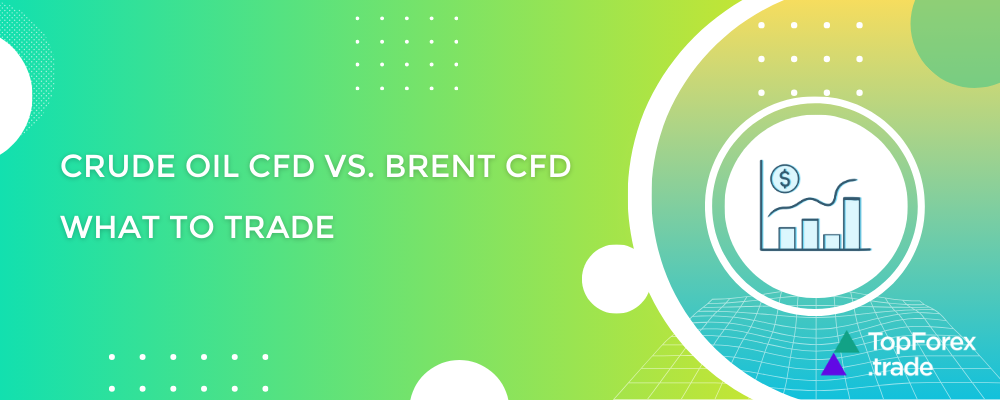Crude Oil CFDs vs. Brent CFDs: what is the difference, and how to trade

Crude oil and Brent oil are two key benchmarks in the global oil market, and when trading CFDs (Contracts for Difference), traders have the option to speculate on the price movements of these two types of oil. While both represent oil, they differ in origin, pricing, and market dynamics. In this article, we’ll take a closer look at Crude Oil CFDs and Brent CFDs, their differences, advantages, disadvantages, and how you can trade them.
👉 Don’t want to wait or read through everything? Scroll down to check out the Top FX brokers for trading Crude Oil and Brent CFDs! ⬇️
What are Crude Oil CFDs and Brent CFDs?
➡ Crude Oil CFDs: These refer to CFDs based on WTI (West Texas Intermediate) crude oil, which is often used as a benchmark for oil prices in North America. It is considered a “light sweet” crude due to its low sulfur content, making it ideal for refining into gasoline and other petroleum products. Crude Oil CFDs allow traders to profit from price movements in WTI without having to own the physical oil.
➡ Brent Oil CFDs: Brent Crude is extracted from the North Sea and serves as the main benchmark for oil prices globally, particularly in Europe, Africa, and the Middle East. Like Crude Oil CFDs, Brent CFDs enable traders to speculate on price movements without holding the underlying asset. Brent oil is also considered “light sweet,” but due to its location and global demand, it often behaves differently than WTI crude.
🌍 Note: WTI = U.S.-centric, Brent = global benchmark.
⚙️ Pro tip: Use both CFDs to diversify risk based on geographic market trends.
Key differences between Crude Oil CFDs and Brent CFDs?
| Feature | Crude Oil (WTI) CFDs | Brent Oil CFDs |
|---|---|---|
| Origin | West Texas, USA | North Sea, Europe |
| Pricing | Typically lower than Brent | Typically higher due to international demand |
| Market | Primarily U.S.-focused | Global demand, particularly in Europe, Africa, and the Middle East |
| Quality | Low sulfur, light, and sweet | Low sulfur, light, and sweet |
| Supply | More affected by U.S. production | More affected by geopolitical factors and international supply chains |
Pros and cons of Crude Oil CFDs

➕ Pros
- U.S. market sensitivity: Crude Oil CFDs tend to reflect U.S. oil production and demand closely, making them ideal for traders focusing on the U.S. economy.
- Liquidity: Crude oil is one of the most traded commodities in the world, ensuring high liquidity.
- Lower volatility: Compared to Brent, Crude Oil often experiences less volatility due to its direct connection to U.S. production and consumption.
🧠 Pro tip: WTI is ideal for traders who follow U.S. economic data releases (e.g., EIA reports).
➖ Cons
- Geopolitical exposure: U.S. politics and energy policies (such as shale oil regulations) can heavily influence WTI prices.
- Price discrepancy: Since WTI is generally priced lower than Brent, it might not reflect global oil price fluctuations as accurately.
Pros and cons of Brent Oil CFDs
➕ Pros
- Global benchmark: Brent is used as a global oil benchmark, making it a widely accepted reference for oil pricing.
- International focus: Brent prices are influenced by global geopolitical events, which can create more trading opportunities for international traders.
- Higher demand: Brent oil tends to be in higher demand globally, especially in Europe and Asia, meaning it can be more sensitive to global oil market movements.
🔄 Pro tip: More volatility = more opportunities and risk – always set stop-losses.
➖ Cons
- Higher volatility: Brent oil can be more volatile due to its international exposure, making it riskier for some traders.
- Price premium: Since Brent oil is often priced higher than WTI, it can be more expensive to trade, especially when trading on margin.
What affects Brent Oil and Crude Oil CFDs prices?

Crude Oil CFDs (WTI) factors:
- U.S. shale production: Increased U.S. production can drive WTI prices lower.
- U.S. oil inventories: Rising inventories signal oversupply, lowering prices.
- Economic data: U.S. economic growth boosts demand, pushing prices up.
- Natural disasters: Events like hurricanes disrupt U.S. production, causing price spikes.
- U.S. dollar strength: A stronger dollar can reduce demand, pushing prices lower.
Brent Oil CFDs Factors:
- Geopolitical tensions: Conflicts in key regions (e.g., the Middle East) can cause price volatility.
- OPEC decisions: OPEC’s production cuts or increases significantly affect Brent pricing.
- Global demand: Economic growth or downturns impact worldwide demand for Brent oil.
- Global economic indicators: International trade and economic conditions influence prices.
- Currency movements: Shifts in the U.S. dollar and other currencies can affect global demand for Brent.
How to trade Crude Oil and Brent CFDs: examples
Trading Crude Oil CFDs and Brent CFDs allows traders to speculate on oil price movements without owning the physical commodity. You can go long (buy) if you expect prices to rise or short (sell) if you expect a drop. Here’s how it works in practice:
- Example 1: Trading WTI Crude Oil CFD (buy position)
Suppose WTI Crude is trading at $75.00 per barrel. You believe U.S. oil inventories will drop this week, pushing prices up. You open a buy position for 1 lot (1,000 barrels). If the price rises to $78.00, your profit would be:
($78.00 – $75.00) × 1,000 = $3,000 profit (excluding spreads and fees). - Example 2: Trading Brent CFD (sell position)
Brent Oil is currently priced at $85.00 per barrel. You anticipate that OPEC will increase production, which could lower global oil prices. You open a sell position for 1 lot. If the price falls to $82.50, your profit is:
($85.00 – $82.50) × 1,000 = $2,500 profit (excluding spreads and fees). - Risk management example
Say you’re unsure how volatile the market might be after a major geopolitical event. You place a stop-loss order at $1 below your entry point to limit your downside if the trade goes against you.
For instance, if you bought WTI at $76.00 and placed a stop-loss at $75.00, your potential loss is capped at $1,000 per lot.
Top FX brokers to trade Crude Oil and Brent CFDs
When it comes to trading Crude Oil and Brent CFDs, choosing a reliable broker is essential. Here are some top forex brokers that offer excellent conditions for trading oil CFDs:
🧩 Note: Each broker has strengths – choose based on platform, spreads, leverage, and education tools.
🎯 Pro tip: Use demo accounts to test oil strategies risk-free before committing capital.
AvaTrade oil trading
AvaTrade is known for its advanced trading tools, including powerful technical indicators and customizable charts, perfect for analyzing oil price trends. It offers Brent and WTI CFDs, with competitive spreads, high leverage, and multiple platforms like MetaTrader and AvaTradeGO.
XTB oil trading
XTB combines a strong educational hub with a reliable trading environment. Traders get access to Crude Oil and Brent CFDs, detailed market analysis, and the xStation 5 platform, which is intuitive and loaded with powerful features. A great choice for those who want to sharpen their trading skills while in the market.
Exness oil trading
Exness is well-regarded for its low fees, flexible leverage, and ultra-fast execution. It provides traders access to a wide array of instruments, including Brent and WTI CFDs, making it a popular option for active traders who seek efficiency and competitive pricing.
HF Markets oil trading
HF Markets offers an excellent blend of fast execution, multiple account types, and support for trading bots and strategies. With access to Crude Oil and Brent CFDs, it’s a solid choice for both manual and automated traders. The broker also provides a demo account for testing strategies risk-free.
eToro oil trading
eToro is a globally recognized platform that offers user-friendly CFD trading on both Crude Oil (WTI) and Brent. With tight spreads, commission-free trading, and an innovative copy trading feature, it’s ideal for both beginners looking to learn and experienced traders who want to mirror pro strategies.
Risk disclaimer: eToro is a multi-asset platform which offers both investing in stocks and cryptoassets, as well as trading CFDs.
CFDs are complex instruments and come with a high risk of losing money rapidly due to leverage. 61% of retail investor accounts lose money when trading CFDs with this provider. You should consider whether you understand how CFDs work, and whether you can afford to take the high risk of losing your money.
This communication is intended for information and educational purposes only and should not be considered investment advice or investment recommendation. Past performance is not an indication of future results.
Copy Trading does not amount to investment advice. The value of your investments may go up or down. Your capital is at risk.
Don’t invest unless you’re prepared to lose all the money you invest. This is a high-risk investment and you should not expect to be protected if something goes wrong. Take 2 mins to learn more.
eToro USA LLC does not offer CFDs and makes no representation and assumes no liability as to the accuracy or completeness of the content of this publication, which has been prepared by our partner utilizing publicly available non-entity specific information about eToro.
Related articles:
Trading Crude Oil and Brent CFDs - FAQ